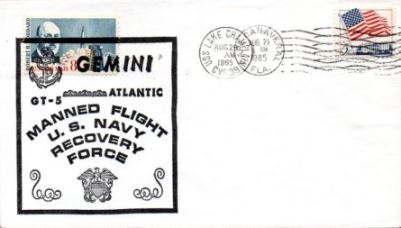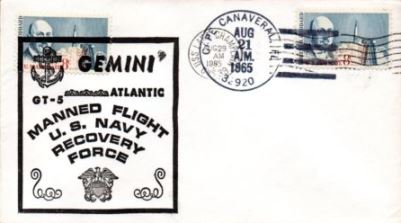Space Cover 456: Gemini 5 Launch and SplashdownGemini 5 launched from Cape Canaveral's Launch Complex 19 and would, over the course of the flight, double the U.S space-flight record of the Gemini 4 mission to eight days - the expected length of time it would take to fly to the Moon, land and return. Gemini 5 carried new fuel cells that generated enough electricity to power longer missions instead of the "normal" chemical batteries used on previous manned spacecraft. Gordon Cooper (on his second spaceflight) and Pete Conrad (first flight) were to have made a practice space rendezvous with a "pod" deployed from the spacecraft, but problems with the electrical supply forced a switch to a simpler "phantom rendezvous," whereby the Gemini craft maneuvered to a predetermined position in space.
The launch went perfectly except for a few seconds of Pogo oscillation traced to improper gas levels in an oxidizer standpipe. Conrad and Cooper found their vision and speech momentarily impaired by the strong vibrations.
The ejection of the Rendezvous Evaluation Pod (REP) occurred at 2 hours and 13 minutes into the flight. At 4 hours and 22 minutes into the flight, the crew found that the pressure in one of the capsules fuel cells had dropped from 850 to 65 pounds per square inch so the crew shut the fuel cells down. With only battery power, they would be unable to rendezvous with the REP, and it could also mean a premature end to the mission - they would only be able to stay in orbit for a day and still have enough battery power for reentry.
Engineers performed tests on similar cells and determined that it was possible for the fuel cell to work, even with low oxygen pressure. Thus, it was decided to turn the fuel cells back on and test them by using equipment that required more and more power. These tests showed that the fuel cells were stable and the crew could continue the mission.
In the meantime, Buzz Aldrin had been working out an alternative rendezvous test and worked out a procedure where the crew could rendezvous with a given point in space. The phantom rendezvous went as planned, even though it was the first precision maneuver on a spaceflight. The crew tried four maneuvers — apogee adjust, phase adjust, plane change, and coelliptical maneuver—using the orbit attitude and maneuvering system.
The capsule landed 80 miles short of the planned landing point in the Atlantic Ocean. This was not caused by a computational software error but the still common data entry error, as a programmer had entered the rate of the Earth's rotation as 360° per 24 hours instead of 360.98°.
The crew and capsule were recovered by the prime recovery ship USS Lake Champlain.

The pictured covers have a Cape Canaveral launch cancel AND a USS Lake Champlain machine cancel for the recovery. As seen, the Cape Canaveral cancels occur in both hand and machine cancel versions. All covers with launch and recovery cancels that I have seen (less than 5 total) have the same stamp placements at the top of the envelopes leading my speculation to be that there was a single source for all of the covers with the dual cancels. Anyone know who had the forethought to create these interesting covers? These covers appear pretty infrequently so if you have the chance to obtain one...
As a side note on recent spaceflight data errors: A bad data input to the Ariane 5 rocket’s guidance system that was missed during pre-launch quality control checks caused the launcher to deviate from its expected flight path and place the SES 14 and Al Yah 3 communications satellites in the wrong orbit January 25, 2018. The guidance settings for the November 28, 2017 Soyuz-21b launch were for a launch departing from the Baikonur Cosmodrome in Kazakhstan, the Russian space program’s primary launch site, and not the new Vostochny Cosmodrome in Russia’s Far East where the launch actually took place leaving Russia’s Meteor M2-1 weather satellite and 18 co-passengers for U.S., Canadian, European and Japanese companies short of their planned orbit, and the spacecraft burned up on re-entry with the Fregat stage over the Atlantic Ocean.













